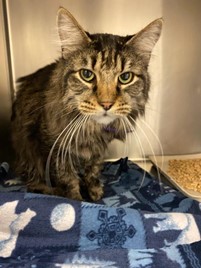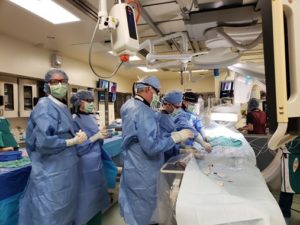
Gut Microbial Dysbiosis
Species affected: humans, felines, canines
Description:
Symbiosis describes an established relationship between two or more organisms that rely on each other to survive. The microbiome is often described as a “symbiotic relationship” between the host’s microbes and the host. With symbiosis, the host harbors a healthy balance of each microbial community in a manner that is beneficial to the host. However, dysbiosis can also occur. Dysbiosis, also called dysbacteriosis, occurs when there is an imbalance (either in number or type) of microbial communities that have colonized the host. Dysbiosis can negatively impact a host’s wellbeing. For example, in humans and animals, dysbiosis can negatively affect digestion and cause uncontrolled inflammation. In general, dysbiosis caused by decreased microbial diversity within the microbiome leads to increased risk of disease or infection to the host. On the other hand, a symbiotic microbiome impacts wellbeing in a variety of ways, such as regulating a healthy immune system, proper vitamin production, and offering protection against pathogens that cause disease.
Importantly, the microbiota within the gastrointestinal tract of humans and animals use their own digestive enzymes to help break down compounds from foods that would otherwise be indigestible such as certain fibers. While fermenting these fibers, bacteria produce short chain fatty acids (SCFA). SCFA serve as an important nutrient. For instance, they impact normal muscle function and prevent excessive inflammation. Therefore, not only are the microbial communities within the microbiome essential to their host’s overall wellbeing, but their microbial byproducts and metabolites are as well.
This article focuses on the gut microbiome, however everything in life harbors a microbiome. Because of its connection to health and disease, the human microbiome has been researched extensively in recent years and has been coined our “second genome.” In humans and other animals, the oral, skin, and GI microbiome are frequently the focus of attention, but microbiomes exist throughout our entire body. For example, investigators have now begun to research the microbiome in the male and female reproductive tracts to further understand how microbiota impact reproductive competence. Likewise, researchers have also begun to characterize the ocular microbiome to understand its role in ocular diseases and healthy eyesight. Interestingly, not only are microbiomes critical to the vitality of living organisms, but non-living substances (such as soil, water, and air) also contain microbiomes that affect our health and wellbeing. For example, the use of pesticides and food chemicals not only impact human and animal health by disrupting our microbiomes, but they also have agricultural implications that impact crop health by altering both the soil and plant microbiomes. For this reason, research on the microbiome can implications for humans, animals, and the shared environment.
Significant Similarities and Differences Between Affected Species:
The human microbiome consists of trillions of microbes (e.g. bacteria, viruses, and fungi) that are harbored within and on the human bodies and are critical to human health. Human bodies contain about 10 times as many microbial cells as compared to human cells. In fact, a human microbiome typically weighs more than a human brain. Companion animals, such as dogs, also contain microbes that are essential to their wellbeing. The microbiome harbored within an animal can impact its health and wellbeing in the very same way it impacts human health. In fact, dogs, who have shared our environment and food for a long time, share many similarities with the human gut microbiome potentially making them both a good sentinel for disease and model for treatments in dogs and people (Trinh et al., 2018).
Disease Etiology:
Several factors, such as antibiotic use and diets low in fiber, can lead to dysbiosis. A dietary change that increases intake of sugars, proteins, or food additives while decreasing fiber disrupts gut flora and leads to microbial dysbiosis. Importantly—especially to human and animal medical experts—new medications (such as antibiotics) can lead to microbial dysbiosis by diminishing certain bacterial strains and/or allowing other bacteria to grow, disrupting the microbial balance. Another cause of dysbiosis is accidental chemical consumption that can disrupt the gut flora, such as lingering pesticides on unwashed fruits and vegetables. High levels of stress and anxiety have also been shown to disrupt the microbiome and cause dysbiosis, which in turn weakens the host’s immune system. In humans, drinking more than two alcoholic beverages per day has also been shown to cause disbalance of gut flora.
Dysbiosis has been linked to several diseases, such as inflammatory bowel disease (IBD), diabetes, and obesity, among others. With respect to IBD, an imbalanced gut flora has long been associated with inflammation, specifically within the gastrointestinal tract. More research is needed to establish a causal relationship between dysbiosis and IBD, but current literature shows that as the global incidence of IBD increases, so does dysbiosis. In recent years, a vast amount of literature has suggested that – in addition to other causes – an imbalance between harmful and protective intestinal bacteria can be responsible for a surge in IBD prevalence. In addition, numerous studies have confirmed that a dysbiotic microbiome plays a significant role in the etiology of type 2 diabetes and obesity. Interestingly, research has shown that germ-free mice (i.e., mice lacking all microorganisms) that receive “obese fecal microbiota” transplants (i.e., fecal transplants from obese mice) gained more weight as compared to those receiving a microbiota transplant from lean donor mice (Sun et al., 2018). Similar research has been published linking microbial dysbiosis and type 2 diabetes. While the exact mechanisms underlying these phenotypes are unknown, the data suggests dysbiosis plays a role in IBD, obesity, and type 2 diabetes.
Clinical Presentation:
Due to the broad impact of the microbiome on overall health, the clinical presentation for gut microbial dysbiosis comes in many forms. Symptoms can vary based on location of dysbiosis and depending on which types of bacteria are out of balance. Common symptoms of gut microbial dysbiosis are nausea, constipation, diarrhea, bloating, or an upset stomach. Other signs of dysbiosis include fatigue, anxiety, depression, difficulty concentrating, chest pain, and a rash or redness—among many others. Many of these adverse symptoms are due to the bidirectional communication system between the central and enteric nervous system, also known as the gut-brain axis (GBA). Research on the GBA suggests a link between dysbiosis and abnormal responses in the emotional and cognitive centers of the brain.
Diagnosis:
In most cases, to decipher if gut microbial dysbiosis is present within an animal, an examination of a fecal sample is necessary. Specifically, a comprehensive digestive stool analysis will be performed on the fecal sample to determine the types and amounts of bacteria and yeast present. These studies can be very complex to perform and analyze, but the results can help ascertain if there is a lack of diversity, an overgrowth, or an imbalance. Research in this area is ongoing to help better understand and assess the complexity of the microbiome and its impact on health and disease.
Treatment:
Many factors need to be considered to reestablish a well-balanced microbial community within a host’s digestive system. If a medication, such as an antibiotic, is suspected to be the root of the dysbiosis, options such as supplementation with pre- and/or probiotics may be tried, and the medication may be changed or discontinued if possible. The potential for significant and long-lasting influence on the microbiome and thereby patient health is one of the many reasons for ensuring purposeful use of medications such as antibiotics. If diet is the cause of microbial imbalance and dysbiosis, a new nutrition plan may be implemented often times resulting in a shift towards foods richer in fiber. Additionally, in some instances vitamins and supplements may prove beneficial in establishing a more balanced, symbiotic microbiome. However, any changes need to incorporate the patient’s medical care team to ensure the best outcomes as there is much that is unknown and many interactions that can occur in an individual. As we continue to advance our understanding of the microbiome, additional treatments are being investigated, such as fecal matter transplant.
Using Animals as Models for the Human Microbiome:
Several animal models have been used to investigate the gut microbiome and its impact on health and wellbeing. Pigs are often chosen as animal models for nutrition studies since their gastrointestinal tracts, diet, and phenotype closely resemble that of humans (Coelho et al., 2018). Recently, dogs have emerged as a potentially powerful natural animal model to study the microbiome. Humans and dogs have lived in close quarters for 20,000-40,000 years, and dogs have both been exposed to many of the same microbes, environments, diets, activities, and lifestyle changes as humans and develop many diseases in common with humans. Studies of the relationship between the microbiome and diseases such as IBD and obesity in dogs has the potential to help both dogs and their owners.
Current Investigators:
Dr. Jessica L. Metcalf
Dr. Zaid Abdo
Dr. Elizabeth Ryan
Dr. Joshua Chan
Other Natural Animal Models:
References:
Carabotti, M., Scirocco, A., Maselli, M. A., & Severi, C. (2015). The gut-brain axis: interactions between enteric microbiota, central and enteric nervous systems. Annals of gastroenterology, 28(2), 203–209.
Clapp, M., Aurora, N., Herrera, L., Bhatia, M., Wilen, E., & Wakefield, S. (2017). Gut Microbiota’s Effect on Mental Health: The Gut-Brain Axis. Clinics and Practice, 7(4), 131–136. https://doi.org/10.4081/cp.2017.987
Coelho, L.P., Kultima, J.R., Costea, P.I. et al. Similarity of the dog and human gut microbiomes in gene content and response to diet. Microbiome 6, 72 (2018). https://doi.org/10.1186/s40168-018-0450-3
Defois, C., Ratel, J., Garrait, G. et al. Food Chemicals Disrupt Human Gut Microbiota Activity And Impact Intestinal Homeostasis As Revealed By In Vitro Systems. Sci Rep 8, 11006 (2018). https://doi.org/10.1038/s41598-018-29376-9
DeGruttola, A. K., Low, D., Mizoguchi, A., & Mizoguchi, E. (2016). Current Understanding of Dysbiosis in Disease in Human and Animal Models. Inflammatory bowel diseases, 22(5), 1137–1150. https://doi.org/10.1097/MIB.0000000000000750
Franasiak, J. M., & Scott, R. T., Jr (2015). Reproductive tract microbiome in assisted reproductive technologies. Fertility and sterility, 104(6), 1364–1371. https://doi.org/10.1016/j.fertnstert.2015.10.012
Hooda, S., Minamoto, Y., Suchodolski, J. S., & Swanson, K. S. (2012). Current state of knowledge: the canine gastrointestinal microbiome. Animal Health Research Reviews, 13(1), 78–88. Cambridge University Press.
Hooks, K. B., & O’Malley, M. A. (2017). Dysbiosis and Its Discontents. mBio, 8(5), e01492-17. https://doi.org/10.1128/mBio.01492-17
Kaur, N., Chen, C. C., Luther, J., & Kao, J. Y. (2011). Intestinal dysbiosis in inflammatory bowel disease. Gut Microbes, 2(4), 211–216. https://doi.org/10.4161/gmic.2.4.17863
Kittipibul, T., Puangsricharern, V. & Chatsuwan, T. Comparison of the ocular microbiome between chronic Stevens-Johnson syndrome patients and healthy subjects. Sci Rep 10, 4353 (2020). https://doi.org/10.1038/s41598-020-60794-w
Kriss, M., Hazleton, K. Z., Nusbacher, N. M., Martin, C. G., & Lozupone, C. A. (2018). Low diversity gut microbiota dysbiosis: drivers, functional implications and recovery. Current opinion in microbiology, 44, 34–40. https://doi.org/10.1016/j.mib.2018.07.003
Li, X., Watanabe, K., & Kimura, I. (2017). Gut Microbiota Dysbiosis Drives and Implies Novel Therapeutic Strategies for Diabetes Mellitus and Related Metabolic Diseases. Frontiers in Immunology, 8, 1882. https://doi.org/10.3389/fimmu.2017.01882
Luke K Ursell, Jessica L Metcalf, Laura Wegener Parfrey, Rob Knight, (2012). Defining the human microbiome, Nutrition Reviews, Volume 70, Issue suppl_1, 1 August 2012, Pages S38–S44, https://doi.org/10.1111/j.1753-4887.2012.00493.x
Meng, Z., Liu, L., Yan, S., Sun, W., Jia, M., Tian, S., Huang, S., Zhou, Z., & Zhu, W. (2020). Gut Microbiota: A Key Factor in the Host Health Effects Induced by Pesticide Exposure?. Journal of agricultural and food chemistry, 68(39), 10517–10531. https://doi.org/10.1021/acs.jafc.0c04678
Ni, J., Wu, G., Albenberg, L. et al. Gut microbiota and IBD: causation or correlation?. Nat Rev Gastroenterol Hepatol 14, 573–584 (2017). https://doi.org/10.1038/nrgastro.2017.88
Ozkan, J., & Willcox, M. D. (2019). The Ocular Microbiome: Molecular Characterisation of a Unique and Low Microbial Environment. Current eye research, 44(7), 685–694. https://doi.org/10.1080/02713683.2019.1570526
Pilla, R., & Suchodolski, J. S. (2020). The Role of the Canine Gut Microbiome and Metabolome in Health and Gastrointestinal Disease. Frontiers in veterinary science, 6, 498. https://doi.org/10.3389/fvets.2019.00498
Song, S. J., Lauber, C., Costello, E. K., Lozupone, C. A., Humphrey, G., Berg-Lyons, D., Caporaso, J. G., Knights, D., Clemente, J. C., Nakielny, S., Gordon, J. I., Fierer, N., & Knight, R. (2013). Cohabiting family members share microbiota with one another and with their dogs. eLife, 2, e00458. https://doi.org/10.7554/eLife.00458
Sroka-Oleksiak, A., Młodzińska, A., Bulanda, M., Salamon, D., Major, P., Stanek, M., & Gosiewski, T. (2020). Metagenomic Analysis of Duodenal Microbiota Reveals a Potential Biomarker of Dysbiosis in the Course of Obesity and Type 2 Diabetes: A Pilot Study. Journal of Clinical Medicine, 9(2), 369. https://doi.org/10.3390/jcm9020369
Sun, L., Ma, L., Ma, Y., Zhang, F., Zhao, C., & Nie, Y. (2018). Insights into the role of gut microbiota in obesity: pathogenesis, mechanisms, and therapeutic perspectives. Protein & Cell, 9(5), 397–403. https://doi.org/10.1007/s13238-018-0546-3
Tamboli, C. P. (2004). Dysbiosis in inflammatory bowel disease. Gut, 53(1), 1–4. https://doi.org/10.1136/gut.53.1.1
Thomas, S., Izard, J., Walsh, E., Batich, K., Chongsathidkiet, P., Clarke, G., Sela, D. A., Muller, A. J., Mullin, J. M., Albert, K., Gilligan, J. P., DiGuilio, K., Dilbarova, R., Alexander, W., & Prendergast, G. C. (2017). The Host Microbiome Regulates and Maintains Human Health: A Primer and Perspective for Non-Microbiologists. Cancer research, 77(8), 1783–1812. https://doi.org/10.1158/0008-5472.CAN-16-2929
Trinh, P., Zaneveld, J. R., Safranek, S., & Rabinowitz, P. M. (2018). One Health Relationships Between Human, Animal, and Environmental Microbiomes: A Mini-Review. Frontiers in public health, 6, 235. https://doi.org/10.3389/fpubh.2018.00235
Tu, P., Chi, L., Bodnar, W., Zhang, Z., Gao, B., Bian, X., Stewart, J., Fry, R., & Lu, K. (2020). Gut Microbiome Toxicity: Connecting the Environment and Gut Microbiome-Associated Diseases. Toxics, 8(1), 19. https://doi.org/10.3390/toxics8010019
Zheng, D., Liwinski, T., & Elinav, E. (2020). Interaction between microbiota and immunity in health and disease. Cell research, 30(6), 492–506. https://doi.org/10.1038/s41422-020-0332-7
Zhou, M., & Zhao, J. (2021). A Review on the Health Effects of Pesticides Based on Host Gut Microbiome and Metabolomics. Frontiers in molecular biosciences, 8, 632955. https://doi.org/10.3389/fmolb.2021.632955





